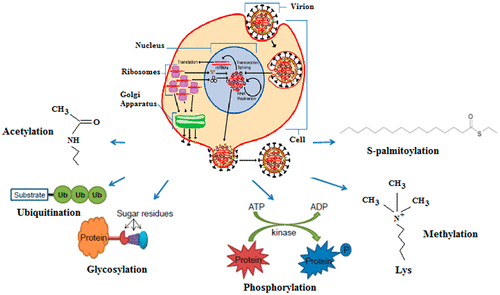当前位置:
X-MOL 学术
›
J. Proteome Res.
›
论文详情
Our official English website, www.x-mol.net, welcomes your
feedback! (Note: you will need to create a separate account there.)
Proteomics in Influenza Research: The Emerging Role of Posttranslational Modifications
Journal of Proteome Research ( IF 3.8 ) Pub Date : 2020-12-21 , DOI: 10.1021/acs.jproteome.0c00778 Jinming Zhang 1 , Qisheng Peng 1 , Weizheng Zhao 2 , Wanchun Sun 1 , Jingbo Yang 1 , Ning Liu 1
Journal of Proteome Research ( IF 3.8 ) Pub Date : 2020-12-21 , DOI: 10.1021/acs.jproteome.0c00778 Jinming Zhang 1 , Qisheng Peng 1 , Weizheng Zhao 2 , Wanchun Sun 1 , Jingbo Yang 1 , Ning Liu 1
Affiliation

|
Influenza viruses continue evolving and have the ability to cause a global pandemic, so it is very important to elucidate its pathogenesis and find new treatment methods. In recent years, proteomics has made important contributions to describing the dynamic interaction between influenza viruses and their hosts, especially in posttranslational regulation of a variety of key biological processes. Protein posttranslational modifications (PTMs) increase the diversity of functionality of the organismal proteome and affect almost all aspects of pathogen biology, primarily by regulating the structure, function, and localization of the modified proteins. Considerable technical achievements in mass spectrometry-based proteomics have been made in a large number of proteome-wide surveys of PTMs in many different organisms. Herein we specifically focus on the proteomic studies regarding a variety of PTMs that occur in both the influenza viruses, mainly influenza A viruses (IAVs), and their hosts, including phosphorylation, ubiquitination and ubiquitin-like modification, glycosylation, methylation, acetylation, and some types of acylation. Integration of these data sets provides a unique scenery of the global regulation and interplay of different PTMs during the interaction between IAVs and their hosts. Various techniques used to globally profiling these PTMs, mostly MS-based approaches, are discussed regarding their increasing roles in mechanical regulation of interaction between influenza viruses and their hosts.
中文翻译:

蛋白质组学在流感研究中:翻译后修饰的新兴作用
流感病毒不断发展并具有引起全球性大流行的能力,因此阐明其发病机理并寻找新的治疗方法非常重要。近年来,蛋白质组学为描述流感病毒与其宿主之间的动态相互作用做出了重要贡献,尤其是在翻译过程中对多种关键生物学过程的调控中。蛋白质翻译后修饰(PTM)主要通过调节修饰蛋白质的结构,功能和定位,增加了生物蛋白质组功能的多样性并影响病原体生物学的几乎所有方面。在许多不同生物体中对PTM进行的大量蛋白质组范围调查中,基于质谱的蛋白质组学取得了可观的技术成就。本文中,我们特别关注有关蛋白质组学的研究,这些蛋白质组学研究涉及流感病毒(主要是甲型流感病毒(IAV))及其宿主的多种PTM,包括磷酸化,泛素化和泛素样修饰,糖基化,甲基化,乙酰化和某些类型的酰化。这些数据集的集成提供了IAV与主机之间交互过程中不同PTM的全局调节和相互作用的独特景象。讨论了用于全局剖析这些PTM的各种技术(主要是基于MS的方法),这些技术在流感病毒与其宿主之间相互作用的机械调节中起着越来越重要的作用。包括磷酸化,泛素化和类泛素修饰,糖基化,甲基化,乙酰化和某些类型的酰化。这些数据集的集成提供了IAV与主机之间交互过程中不同PTM的全局调节和相互作用的独特景象。讨论了用于全局剖析这些PTM的各种技术(主要是基于MS的方法),这些技术在流感病毒与其宿主之间相互作用的机械调节中起着越来越重要的作用。包括磷酸化,泛素化和类似泛素的修饰,糖基化,甲基化,乙酰化和某些类型的酰化。这些数据集的集成提供了IAV与主机之间交互过程中不同PTM的全局调节和相互作用的独特景象。讨论了用于全局剖析这些PTM的各种技术(主要是基于MS的方法),这些技术在流感病毒与其宿主之间相互作用的机械调节中起着越来越重要的作用。
更新日期:2021-01-01
中文翻译:

蛋白质组学在流感研究中:翻译后修饰的新兴作用
流感病毒不断发展并具有引起全球性大流行的能力,因此阐明其发病机理并寻找新的治疗方法非常重要。近年来,蛋白质组学为描述流感病毒与其宿主之间的动态相互作用做出了重要贡献,尤其是在翻译过程中对多种关键生物学过程的调控中。蛋白质翻译后修饰(PTM)主要通过调节修饰蛋白质的结构,功能和定位,增加了生物蛋白质组功能的多样性并影响病原体生物学的几乎所有方面。在许多不同生物体中对PTM进行的大量蛋白质组范围调查中,基于质谱的蛋白质组学取得了可观的技术成就。本文中,我们特别关注有关蛋白质组学的研究,这些蛋白质组学研究涉及流感病毒(主要是甲型流感病毒(IAV))及其宿主的多种PTM,包括磷酸化,泛素化和泛素样修饰,糖基化,甲基化,乙酰化和某些类型的酰化。这些数据集的集成提供了IAV与主机之间交互过程中不同PTM的全局调节和相互作用的独特景象。讨论了用于全局剖析这些PTM的各种技术(主要是基于MS的方法),这些技术在流感病毒与其宿主之间相互作用的机械调节中起着越来越重要的作用。包括磷酸化,泛素化和类泛素修饰,糖基化,甲基化,乙酰化和某些类型的酰化。这些数据集的集成提供了IAV与主机之间交互过程中不同PTM的全局调节和相互作用的独特景象。讨论了用于全局剖析这些PTM的各种技术(主要是基于MS的方法),这些技术在流感病毒与其宿主之间相互作用的机械调节中起着越来越重要的作用。包括磷酸化,泛素化和类似泛素的修饰,糖基化,甲基化,乙酰化和某些类型的酰化。这些数据集的集成提供了IAV与主机之间交互过程中不同PTM的全局调节和相互作用的独特景象。讨论了用于全局剖析这些PTM的各种技术(主要是基于MS的方法),这些技术在流感病毒与其宿主之间相互作用的机械调节中起着越来越重要的作用。











































 京公网安备 11010802027423号
京公网安备 11010802027423号